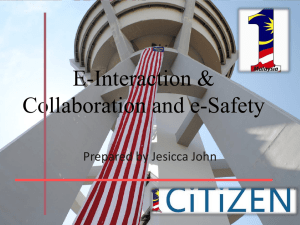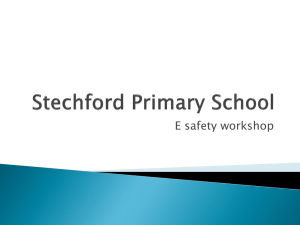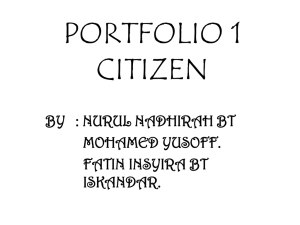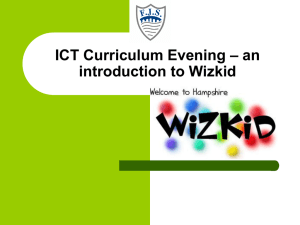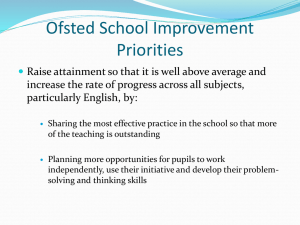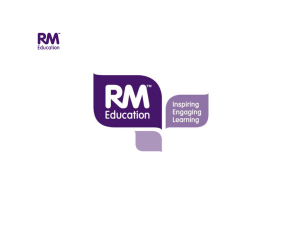e safety conference 2014 Presentation
advertisement
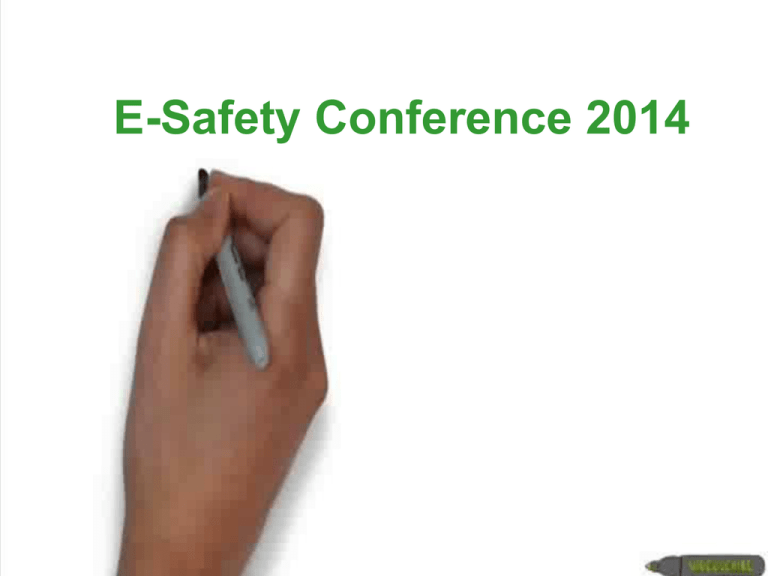
E-Safety Conference 2014 Aims • To raise awareness and give an overview of the emerging e-safety agenda from a schools perspective. • Allow schools to evaluate where they are and allow them to signpost next steps. • Highlight support available to schools. Schedule • • • • • 9:00 – 9:15 9:15 – 9:20 9:20 – 9:40 9:40 – 10:15 10:15 – 10:45 • 10:45 – 11:00 • 11:00 – 11:15 • 11:15 – 11:30 • 11:30 – 11:50 • 11:50 – 12:10 • 12:10 – 12:30 Coffee and registration Welcome What does an E-Safe school look like? Keynote: Simon Finch Workshop: How acceptable is your “ Acceptable Use Policy”? Coffee break E-safety and the new Computing Curriculum OFSTED and E-safety – What are they looking for? Key Bytes!!! Group feedback. Next steps. What does an E-Safe School look like? Feedback - An E- Safe school is… Feedback - what does an e-safe school look like? • Whole school awareness • Techy stuff – forensic monitoring, infrastructure, anti-virus • Safeguarding – cyber bullying • Curriculum - teaching and Learning – Everybody • Policies – AUP, E-safety ( everybody should understand this) • National Events and groups e.g. CEOP • Procedures for managing social media, logging incidents Keynote – Simon Finch Workshop How acceptable is your “Acceptable Use Policy”? Scenario 1 Miss Peach borrows a school iPad and laptop which she takes home. When she is not using it for school work she uses it for personal use. Scenario 2 Sergeant Grey is taking his group on the annual trip to Beamish. He has forgotten the school camera but has his own phone which has a camera attached. He uses this to take pictures. He downloads them to the school network as soon as he gets back. Scenario 3 Ms Gold has had a bad day at school. When she gets home she adds a status to Friendbook to say so. Scenario 4 Professor Plum has spare time at lunchtimes and uses a school machine to research and book his holiday for half term. Scenario 5 Colonel Mustard retired last term. The school have left his school accounts and e mail active for a month so he can organise his affairs. Scenario 6 Mrs White is a disgruntled grandparent and has commented on Friendbook to air a grievance. She has named a teacher at her grandchild’s school. Others have commented on her post. News has spread around the playground! Scenario 7 Dr Black intends to finish his reports at home because he said he had too much to do in school. He will bring the finished documents back in to school and load onto the school network on a memory stick. Scenarios Feedback • • • • Personal use not a family computer Caution with personal banking etc. Staff access monitored and filtered by VPN No – have no control over what doing at home • NO! He shouldn’t use his phone - this is to protect himself and the students Simon disagreed. AUP should be acceptable and enable you to do your job properly Ian – consider the audience of images and where to store them • • • • • • Don’t do it Context of the bad day – at work or at school? Why is there a need to do it? People have a need to be social Scenarios Feedback • • • • Not a problem it is staff personal time Often heads discretion rather than documented Monitoring would be in place Staff should be made aware of what is ‘acceptable’ • Organise his affairs before he leaves • Down to heads discretion some allow restricted access for users after leaving who are still supporting the school in some way • Staff access should be disabled immediately • Can involve police • Legally what can we do? Legal advice has been sought • Need to educate parents re social media Scenarios Feedback • • • • • If encrypted Use remote access or VLE for reports Minimise risks Is e-mail safer? Is email secure – e.g. council advises that sensitive information should not be sent by email New Curriculum Implementation September 2014. The curriculum subject is now called Computing. This continues to incorporate all the facets of the subject, including: • computer science • digital literacy • information technologies. A major inclusion is that of E-safety Aims • can understand and apply the fundamental principles and concepts of computer science, including abstraction, logic, algorithms and data representation • can analyse problems in computational terms, and have repeated practical experience of writing computer programs in order to solve such problems • can evaluate and apply information technology, including new or unfamiliar technologies, analytically to solve problems • are responsible, competent, confident and creative users of information and communication technology Subject content Key Stage 1 Pupils should be taught to: Subject content • understand what algorithms are; how they are implemented as programs on digital Key Stage 1 devices; and that programs execute by following precise and unambiguous instructions • create and debug simple programs • use logical reasoning to predict the behaviour of simple programs • use technology purposefully to create, organise, store, manipulate and retrieve digital content • use technology safely and respectfully, keeping personal information private; know where to go for help and support when they have concerns about material on the internet • recognise common uses of information technology beyond school Subject content Key Stage 2 Key Stage 2 Pupils should be taught to: • • • • • • • design, write and debug programs that accomplish specific goals, including controlling or simulating physical systems; solve problems by decomposing them into smaller parts use sequence, selection, and repetition in programs; work with variables and various forms of input and output use logical reasoning to explain how some simple algorithms work and to detect and correct errors in algorithms and programs understand computer networks including the internet; how they can provide multiple services, such as the world-wide web; and the opportunities they offer for communication and collaboration use search technologies effectively, appreciate how results are selected and ranked, and be discerning in evaluating digital content use technology safely, respectfully and responsibly; know a range of ways to report concerns and inappropriate behaviour select, use and combine a variety of software (including internet services) on a range of digital devices to accomplish given goals, including collecting, analysing, evaluating and presenting data and information. Subject content Key Stage 3 • • • • • • • • • design, use and evaluate computational abstractions that model the state and behaviour of real-world problems and physical systems understand several key algorithms that reflect computational thinking [for example, ones for sorting and searching]; use logical reasoning to compare the utility of alternative algorithms for the same problem use two or more programming languages, at least one of which is textual, to solve a variety of computational problems; make appropriate use of data structures [for example, lists, tables or arrays]; design and develop modular programs that use procedures or functions understand simple Boolean logic [for example, AND, OR and NOT] and some of its uses in circuits and programming; understand how numbers can be represented in binary, and be able to carry out simple operations on binary numbers [for example, binary addition, and conversion between binary and decimal] understand the hardware and software components that make up computer systems, and how they communicate with one another and with other systems understand how instructions are stored and executed within a computer system; understand how data of various types (including text, sounds and pictures) can be represented and manipulated digitally, in the form of binary digits undertake creative projects that involve selecting, using, and combining multiple applications, preferably across a range of devices, to achieve challenging goals, including collecting and analysing data and meeting the needs of known users create, re-use, revise and re-purpose digital artefacts for a given audience, with attention to trustworthiness, design and usability understand a range of ways to use technology safely, respectfully, responsibly and securely, including protecting their online identity and privacy; recognise inappropriate content, contact and conduct and know how to report concerns. Subject content Key Stage 4 • All pupils must have the opportunity to study aspects of information technology and computer science at sufficient depth to allow them to progress to higher levels of study or to a professional career. All pupils should be taught to: • develop their capability, creativity and knowledge in computer science, digital media and information technology • develop and apply their analytic, problem-solving, design, and computational thinking skills • understand how changes in technology affect safety, including new ways to protect their online privacy and identity, and how to identify and report a range of concerns. What does it mean in school? Year 1 Make an avatar using a paint program and display in school. Year 2 Make a cover for a game with PEGI rating on it. Year 3 Make a database of favourite games. Year 4 Make a helpsheet for frequently used abbreviations in textspeak. Year 5 Comment on others work using learning platform or another secure site. Year 6 Create a website or blog including video, images and sounds. Website Resources OFSTED Schools ability… to protect and educate pupils and staff in their use of technology. to have the appropriate mechanisms to intervene and support any incident where appropriate. Breadth of issues within E safety The breadth of issues classified within e-safety is considerable, but can be categorised into three areas of risk: • content: being exposed to illegal, inappropriate or harmful material • contact: being subjected to harmful online interaction with other users • conduct: personal online behaviour that increases the likelihood of, or causes, harm. Key features of good and outstanding practice • • • • • • • • Whole School Consistent Approach Robust and integrated reporting routines Staff Policies Education Infrastructure Monitoring and Evaluating Management of personal data Whole school consistent approach • All teaching and non-teaching staff can recognise and are aware of e-safety issues. • High quality leadership and management make esafety a priority across all areas of the school (the school may also have achieved a recognised standard, for example the e-Safety Mark). • A high priority given to training in e-safety, extending expertise widely and building internal capacity. • The contribution of pupils, parents and the wider school community is valued and integrated. Robust and integrated reporting routines • School-based reporting routes that are clearly understood and used by the whole school, for example online anonymous reporting systems. • Report Abuse buttons, for example CEOP. Clear, signposted and respected routes to key members of staff. Effective use of peer mentoring and support. Staff • All teaching and non-teaching staff receive regular and up-to-date training. • One or more members of staff have a higher level of expertise and clearly defined responsibilities. Policies • Rigorous e-safety policies and procedures are in place, written in plain English, contributed to by the whole school, updated regularly and ratified by governors. • The e-safety policy should be integrated with other relevant policies such as behaviour, safeguarding and anti-bullying. • The e-safety policy should incorporate an Acceptable Usage Policy that is understood and respected by pupils, staff and parents. Education • An age-appropriate e-safety curriculum that is flexible, relevant and engages pupils’ interest; that is used to promote e-safety through teaching pupils how to stay safe, how to protect themselves from harm and how to take responsibility for their own and others’ safety. • Positive rewards are used to cultivate positive and responsible use. • Peer mentoring programmes. Infrastructure • Recognised Internet Service Provider (ISP) or Regional Broadband Consortium (RBC) together with age-related filtering that is actively monitored. Monitoring and Evaluation • Risk assessment taken seriously and used to good effect in promoting e-safety. • Using data effectively to assess the impact of e-safety practice and how this informs strategy. Management of Personal Data • The impact level of personal data is understood and data is managed securely and in accordance with the statutory requirements of the Data Protection Act 1998. • Any professional communications between the setting and clients that utilise technology should: • take place within clear and explicit professional boundaries • be transparent and open to scrutiny • not share any personal information with a child or young person. Indicators of Inadequate Practice • Personal data is often unsecured and/or leaves school site without encryption. • Security of passwords is ineffective, for example passwords are shared or common with all but the youngest children. • Policies are generic and not updated. • There is no progressive, planned e-safety education across the curriculum, for example there is only an assembly held annually. • There is no internet filtering or monitoring. • There is no evidence of staff training. • Children are not aware of how to report a problem. Ofsted Questions to School Leadership • How do you ensure that all staff receive appropriate online safety training that is relevant and regularly up to date? • What mechanisms does the school have in place to support pupils and staff facing online safety issues? • How does the school educate and support parents and whole school community with online safety? Ofsted Questions to School Leadership • Does the school have e-safety policies and acceptable use policies in place? How does the school know that they are clear and understood and respected by all? • Describe how your school educates children and young people to build knowledge, skills and capability when it comes to online safety? How do you assess its effectiveness? Ofsted Questions to pupils • If you felt uncomfortable about anything you saw, or if anybody asked you for your personal details such as your address on the internet would you know where to go for help? • If anybody sent you hurtful messages on the internet or on your mobile phone would you know who to tell? • Can you tell me one of the rules your school has for using the internet? • Can you describe the risks of posting inappropriate content on the internet? Sample Questions for staff • Have you had any training that shows the risks to your and pupils online safety? • Are there policies in place that clearly demonstrate good and safe internet practice for staff and pupils? • Are there sanctions in place to enforce the above policies? • Do all staff understand what is meant by the term cyber-bullying and the effect it can have on themselves and pupils? • Are their clear reporting mechanisms with a set of actions in place for staff or pupils who feel they are being bullied online? • Does the school have any plans for an event on Safer Internet Day? (This is an annual event, now in its fifth year at least, so schools that participate will know about the event). Key Bytes How to deal with an incident E-Safety Competition CPD Courses Digital Footprint 28th Jan and 4th Feb 2014 5th and 12th March 2014 11th February 2014 Data Security Policy Information and ICT Security Policy Available for reuse on www.ictinschools.org Monitoring Solutions Filtering Changes E Safe @ Home Healthy Schools E-Safety • ICT in Schools are in partnership with Healthy Schools team • There is a new strand to healthy schools where schools target specific and meaningful well being priorities in order to improve outcomes for young people. • One of the 7 is e-safety where the school identifies that they would like to target e safety and become a specialist school in that area. They would receive an award and a plaque to illustrate the schools commitment to e safety issues (Ofsted!) • Launch date September 2014 • Contact christina.Hardy@southtyneside.gov.uk • Briefing meeting Thursday 30th January @ OpenZone CLC from 4-5.30pm Over to you… Feedback Next Steps
